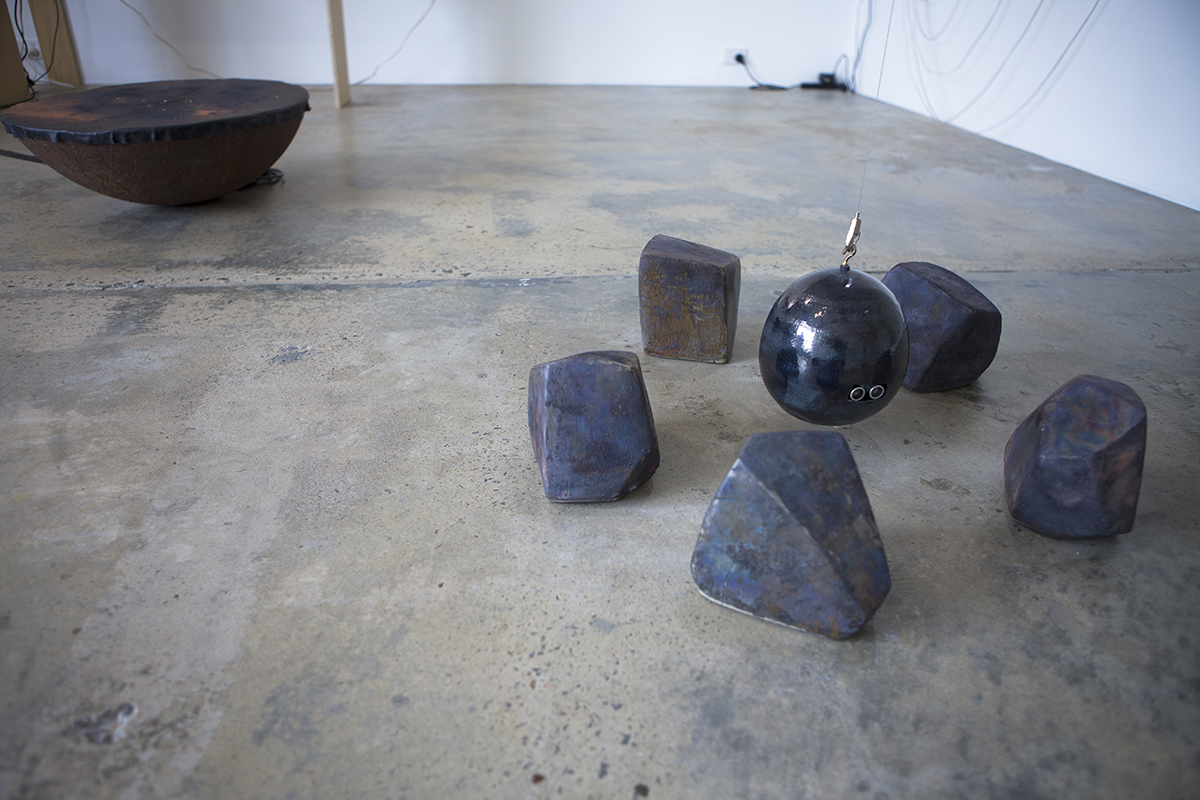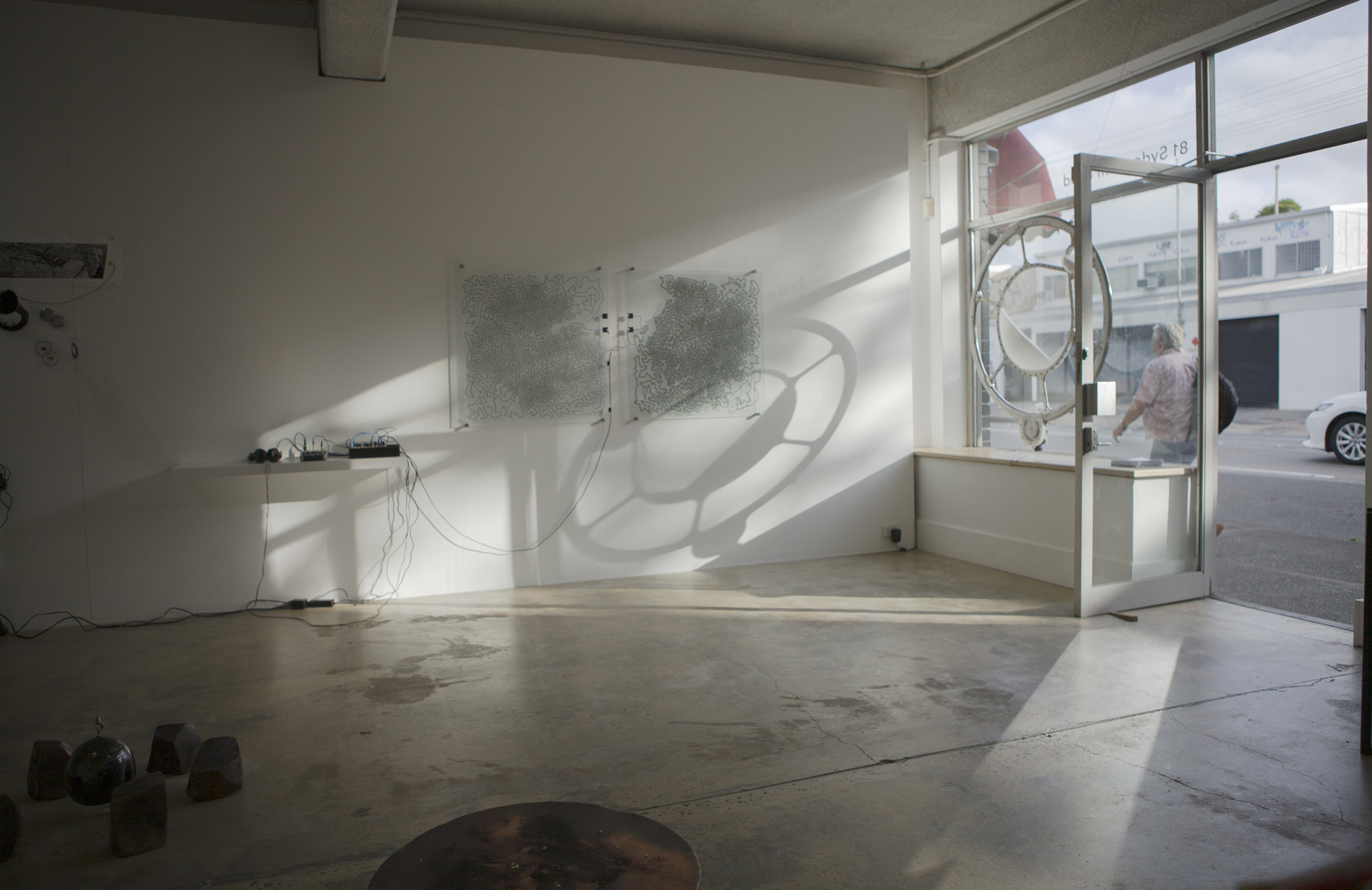What is synthesis?
A synthesizer produces control voltages (CV) and audible oscillations in electronic circuits. Its sounds are made of electricity. Unlike the amplification of vibrating strings, the synthesizer is a wholly electronic instrument. CVs can include audio frequency oscillations but are more often lower frequency signals or triggered voltage events. The modular synthesizer uses patch cables to combine audible oscillations and the CV that shape and colour the sound.
Patch Programming
‘Patch programming’ can be defined as the process of creating connections between different modules with patch cables and knob positions in ways that produce states within the system. ‘The patch’ is a set of states in the system. A patch can involve regular repetition or, as in the case of chaotic oscillations and random voltages, it movements and cycles may never repeat. The works in this exhibition can be thought of as modules in a larger patch. The gallery space as a whole becomes the synthesizer. The footpath beyond the front door of the gallery becomes a site of peripheral synthesis. This exhibition as a patch, the set of states of this particular system, is an instance of expanded synthesis.
Analogue Analogy Generator
Analogue voltages are the common language of modular synthesis, they are the energy that allows one module to speak to another. An analogue is ‘a continuously variable impulse or momentum that can cross from one qualitatively different medium into another. Like electricity into sound waves.’ An analogy is an ‘equivalency or likeness of relations’. The particular relations between the voltages in a synthesizer system that make up a patch can be like many things. The synthesizer is an analogue analogy generator. Synthesizers can produce a likeness of the relations in a living system. All of life’s sensors are analogue. Synthesizers can incorporate analogue sensing. The synthesizer can be both an analogy and an analogue of life’s electrical and energetic processes. The synthesizer can blur the line between analogue and analogy.
Expanded Synthesis
As a field of practice expanded synthesis creates connections through metaphors, analogies, and analogues in the form of electron flux in circuits and patch cables linking synth modules of all kinds. The more abstract or metaphorical dimensions of expanded synthesis are tied to the more concrete domain of electrons in circuits through the bio-electrical processes of thought as embodied action. To think through and about the synthesizer in relation to the the rest of the world is means to expand both thought and synthesis. This is another way of describing what Giles Deleuze and Feliz Guattari call the ‘thought synthesizer’.
Materials and Space
Art as a discipline and form of knowledge can be defined, in part, by its unique understandings of materials and space. Art practice expands the field of synthesis by bringing new material resonances and spatial understandings to the process of synthesizing sound. Joyce Hinterding’s Floric Oscillator (2022) exemplifies these material and spatial dimensions. It is an oscillator made from two electrical components created in graphite on glass panels that are each 85 x 85cm. It is an energy gathering system that responds to capacitive touch. The scale of Floric Oscillator, its materiality, its status as both drawing and functional circuit, its relationship to the history of capacitive interfaces in synthesizers; these things both exemplify expanded synthesis and lead us to think more about what it might be.

A Reflection on Synthesis and Floric Oscillator (2022)
By Joyce Hinterding
Analogue Synthesis, for me, begins with oscillation and feedback, something that not only appears in electronics and sound but in cellular structures, plants and the everyday world, from the positive feedback characterised by amplification to the negative feedback required for maintaining equilibrium or homeostasis. In the world of electronics, these dynamic and energetic processes are described with signs and symbols to make up Circuits.
Floric Oscillator utilises the conductivity and resistivity in the conventional drawing material graphite to literally translate the dynamic states required by a circuit, such as induction and capacitance, to produce a speculative piece of electronics that can be energised. The components follow basic principles but are based on aesthetic observations and translations of Lichen photographed in the Blue Mountains at Knapsack Gully.
Floric Oscillator is a pairing of an active antenna that scavenges electromagnetic energy and a capacitor that stores this energy like a battery. Together, this pairing forms one of the most enigmatic yet fundamental mechanisms in electronics: the tuned or resonant circuit. Commonly called the Tank circuit or the LC circuit, this circuit has only two components an Inductor (a coil or a loop of conductive material) and a capacitor (short-term battery). Once this circuit is energised, it begins to oscillate. Although graphically large, the components are electrically small and are energised by very modest local electromagnetic fields; as a result, the work oscillates in the inaudible MHZ range.
The scavenging ability of the work can be heard in the headphones. Placing your hands on the glass captures your biological energy, resulting in subtle volume increases. Moving your hands and experimenting allows one to engage with this oscillator as a sonic experience.
J.H.
Expanding synthesis to scavenged energy and bioelectricity.


5 raku-fired ceramic stones surround a central ceramic ball. The ceramic ball turns producing a tone that changes sound frequency as it passes each of the ceramic stones. Nearby a drum vibrates moving graphite powder across its surface.
Expanding synthesis to drawing with vibration, and ceramic oscillations.

An electrical heating element warms the air in a glass tube, open at either end. The hot air rises and pressure in the tube builds – cold air is pulled in at the base and the pressure drops. These fluctuations in pressure create an audible standing wave. A tone created by air movement and the precise placement of the heating element reinforcing the propagation of the sound wave through the tube.
Expanding synthesis to thermoacoustic oscillations.

A pressure sensor has been mounted on the wall. It registers the current conditions of the atmosphere feeding them to a module to produce control voltages (CV) that correspond to rising and failing pressure. This CV has been patched to control the pitch of multiple oscillators. When the pressure remains steady between reads a gate triggers an exponentially rising voltage driving a motor that moves a photo reflector down a set of rails, pushing a volume of air towards the wall on which the pressure sensor has been mounted. The CV driving the motor also shapes and colours the sound. When pressure is steady the motor makes it fluctuate by creating a local atmospheric disturbance. An air pressure feedback loop.
Expanding synthesis to global atmospheric dynamics.

A split and etched meteorite reveals crystal planes that have taken 4 billion years to form. A circuit with 3 oscillators, 3 voices, each singing along a crystal plane. A motorised switch chooses pathways along each of the planes, separating them out for individual analysis. The circuit connects to resistive lines printed on a large image of the crystal planes. The circuit travels along the real planes, and their printed representation. Another meteorite is wired in as a shared inductor, with coils from each oscillator wrapped around its iron body, harmonising, reconnecting the separated crystal planes. A process of rationalisation, interrogation, representation, and reconstruction.
Expanding synthesis to crystal structures formed in the vacuum of space and across deep time.

Salt flows in and between two vessels of equal volume – one large, flat and narrow, the other small and spherical. The vessels are held within a slowly rotating wheel. As the salt moves it generates a tilted horizon in the larger vessel. Light gently diffuses through it. The salt’s varying densities create subtle, shifting patterns, both in the salt and in ghostly powder it leaves on the vessels’ surfaces. This work can be thought of as a low frequency oscillator completing one cycle every 2-4 seconds. It is also a kind of noise generator. Susurrations, murmurs and waveforms of salt.
Expanding synthesis to sodium cycles and solar dynamics.
